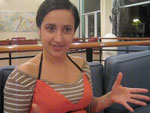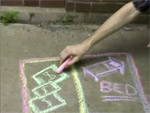 Course: Hearing Voices Through Invisible Walls: The Art(s) of Facilitation
Course: Hearing Voices Through Invisible Walls: The Art(s) of Facilitation
Instructors: Ivy Schweitzer and Pati Hernandez
Video Project, 5-7 minute maximum, to be done in groups, shown to the Dartmouth Community, and assessed according to rubrics determined by the class (see below). This project is one of two culminating group projects for the course, whose overall theme is “Hearing Voices through Invisible Walls.” During the term, we study the way various arts and artists facilitate voices of people who usually go unheard in our society. Five artists, each working in different media, specifically photography/videography, theater, dance (two), and journalism, visited our class and presented their own theories and methods of facilitating voices. They talked to students specifically about their video projects and the issues these projects raised for them. Each visitor helped the students address crucial issues about how and why one facilitates someone’s voice; we encouraged students to think specifically about what they found helpful in these artists’ presentations by requiring them to write short “Critical Reflections” on each artist’s visit, which we commented on and graded.
Our first visitor, Greg Sharrow, an ethnographer at the Vermont Folk Life Center in Middlebury, VT, helped the students navigate a central issue. Our first reading assignment, Paolo Freire’s indispensable philosophy of liberated education, Pedagogy of the Oppressed, stressed the importance of dialogue. Sharrow stressed the importance of the involvement of the facilitator and the necessity of “deep hanging out” to equalize power inequalities between the interviewer (who has the camera and the desire to facilitate) and the interviewee (who faces the camera and may not want to have his/her voice facilitated). Thus, early on students got the idea that only one person could/should facilitate/interview. Greg uncovered a conflict in the class between those who wanted to do the projects in a group and those who wanted to be the solo interviewer. At the end of the class, the members elected to embrace both, and some students did, indeed, choose to work by themselves (though we assigned helpers to these students because edited solo is so time-consuming).
The goal of this project is for each group to produce a short video that facilitates the voice of someone in the Dartmouth community whom the members of the group feel is behind an “invisible wall.” The point is to use video technology and the art of video in the service of voice. Thus, the emphasis is on facilitation and not on the technical production of the videos. The subject of this video project will be determined by students’ specific interests and in consultation with the professors. In approaching their subject, we encouraged students to apply the ideas and methods described by our visiting artists, in the texts we have read and discussed in class, and in the resources on the Blackboard site provided by Susan Simon. This assignment is 20% of the final grade.
First, we required students to hand in a “pitch” to be discussed by the class. A few weeks later, we required students to submit a Video Project Treatment, a form that includes a short description of what they will do, what materials they will include, and what point they are trying to make, what roles everyone in the group will fill. We also asked them to include a short annotated bibliography (minimum of three sources, which can be drawn from the class readings and viewings), 1-2 pages. 5% of final grade.
Rubrics for student assessment of Video Projects: These rubrics were determined by members of the class through a discussion in class that took about 45 minutes. This discussion, although initially frustrating, was extremely helpful because it clarified the aspects of the project everyone thought was the most important––and that was “facilitation,” rather than technical aspects. Although students were, on the whole, leery about assessing each other’s work, even in groups, we felt the determining of rubrics helped them to clarify what was most important to them and to the class.
THEA 10/WGST 59 “Hearing Voices Through Invisible Walls: The Art(s) of Facilitation”
VIDEO PROJECT ASSESSMENTS
Please fill out as a group, one for each video not your own. This will be shown to the group that made the video, and we will use it to assign a grade for the groups on the video projects.
Name of Video:
Name of Students:
I. Facilitation- (40%) 100pts. ________________ x4 _____________
– mutual engagement
– comfort/space
– theory integration (praxis)
II. Organization (30%) 100 pts. _______________ x3 _______________
– focus
– goals
III. Overall Effect (20%) 100 pts. _______________ X2 ________________
– risk taking/daring
– creativity
IV. Production (10%) 100 pts. _______________ x1_________________
– citation
– transitions
TOTAL _______________
Scale:
A=100-95 (97.5)
A-= 94-90 (92.5)
B+=89-87 (88.5)
B =86-84 (85.5)
B-= 83=80 (82)
C+=79-77 (78.5)
C = 76-74 (75.5)
C-=73-70 (72)
D =69-6- (65)
Example of Final Video Project
[youtube xObg8xgfdUw]
 Course: Studio Art 66/68: Architecture II
Course: Studio Art 66/68: Architecture II

 Course: Hearing Voices Through Invisible Walls: The Art(s) of Facilitation
Course: Hearing Voices Through Invisible Walls: The Art(s) of Facilitation Course: Native Cultural Production: (Re)Mapping Race, Gender, and Nation
Course: Native Cultural Production: (Re)Mapping Race, Gender, and Nation Course: Government 83 – Political Communications
Course: Government 83 – Political Communications
